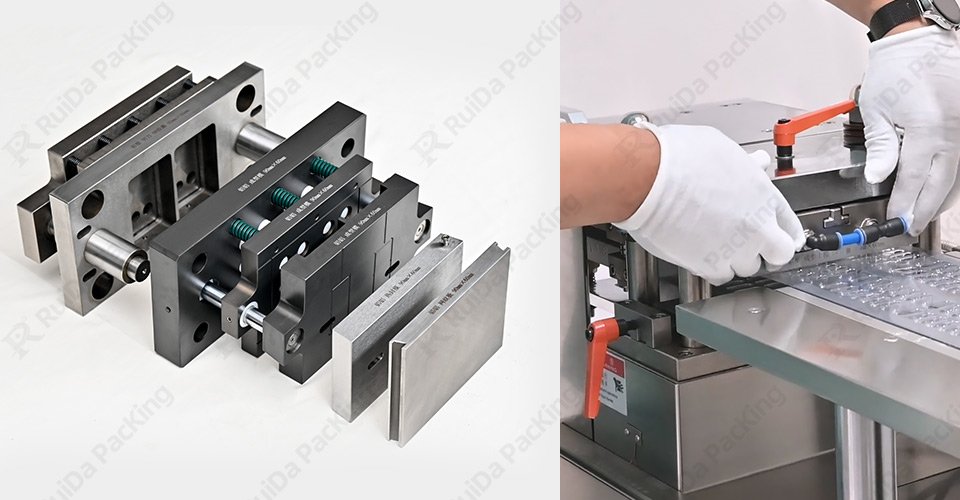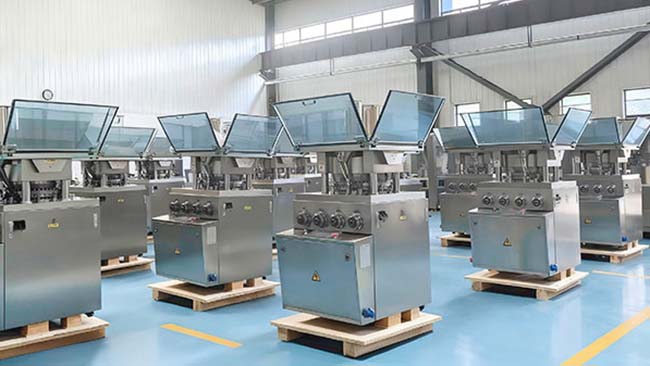Blisterverpackungsmaschinen sind in der Pharma- und Konsumgüterindustrie unverzichtbar, um die sichere Verpackung und den Schutz der Produkte zu gewährleisten. Die ordnungsgemäße Installation und Wartung dieser Maschinen ist entscheidend für einen effizienten und reibungslosen Betrieb. In dieser Anleitung führen wir Sie durch die Installation einer Blisterverpackungsmaschine und erklären Ihnen die wichtigsten Wartungsmaßnahmen für einen reibungslosen Betrieb.

Blisterverpackungsmaschinen verstehen
Bevor wir uns mit der Installation und Wartung befassen, ist es wichtig, die grundlegenden Komponenten und Funktionen einer Blisterverpackungsmaschine zu verstehen. Diese Maschinen dienen zum Formen, Befüllen und Verschließen von Blisterpackungen, die üblicherweise zum Verpacken von Tabletten, Kapseln und anderen kleinen Gegenständen verwendet werden. Die Maschine besteht typischerweise aus folgenden Komponenten:
Formstation
Die Formstation ist der erste und grundlegende Schritt im Blisterverpackungsprozess. Diese Station verwendet entweder Thermoform- oder Kaltformverfahren, um aus einer Kunststoff- oder Aluminiumfolie Blistermulden zu formen. Diese Mulden dienen dazu, die einzelnen Produkte sicher zu halten. Beim Thermoformen wird die Kunststofffolie erhitzt, bis sie biegsam ist, und anschließend mithilfe einer Formmatrize in die gewünschte Form gebracht. Beim Kaltformen hingegen werden weichere Materialien ohne Hitzeeinwirkung geformt. Die Präzision und Konsistenz der Formstation sind entscheidend, um sicherzustellen, dass jeder Blister identisch ist und den verpackten Produkten sowohl Schutz als auch ein professionelles Erscheinungsbild bietet.

Futterstation
Die Zuführstation ist für die präzise Platzierung der Produkte in den geformten Blistermulden verantwortlich. Dieser Prozess kann je nach Maschinenkonstruktion und Art der zu verpackenden Produkte manuell oder automatisiert erfolgen. Automatisierte Zuführsysteme nutzen typischerweise Förderbänder, Vibrationsförderer oder Roboterarme, um die Produkte hochpräzise in den Blister zu positionieren und zu dosieren. Genauigkeit und Effizienz des Zuführprozesses sind entscheidend, da jede Fehlausrichtung oder jedes fehlende Produkt die Integrität und Qualität der Endverpackung beeinträchtigen kann.

Versiegelungsstation
An der Siegelstation werden die gefüllten Blister mit einem Deckmaterial, üblicherweise Aluminiumfolie, versiegelt. Dieser Siegelprozess kann je nach Material und gewünschter Siegelstärke durch Heißsiegeln oder Kaltsiegeln erfolgen. Beim Heißsiegeln wird das Deckmaterial durch Heizelemente mit dem Kunststoffblister verbunden, beim Kaltsiegeln kommt ein Haftklebstoff zum Einsatz. Die Siegelstation muss hinsichtlich Temperatur, Druck und Geschwindigkeit präzise gesteuert werden, um eine starke und luftdichte Versiegelung zu gewährleisten, die das Produkt vor Umwelteinflüssen wie Feuchtigkeit und Verunreinigungen schützt.

Schneidestation
Die Schneidestation ist der letzte Schritt im Blisterverpackungsprozess. Hier werden die versiegelten Blisterpackungen für den Vertrieb und die Verwendung in Einzelstücke geschnitten. Dieser Schneideprozess erfordert hohe Präzision, um sicherzustellen, dass jede Packung saubere, gleichmäßige Kanten aufweist. Je nach Maschinenkonstruktion und Materialeigenschaften kommen verschiedene Schneidetechniken zum Einsatz, darunter mechanisches Schneiden, Laserschneiden und Stanzen. Eine effiziente Schneidestation erhöht die Produktionsgeschwindigkeit und sorgt für ein professionelles Erscheinungsbild jeder Verpackung.

Bedienfeld
Das Bedienfeld dient als zentrale Schnittstelle für die Bedienung und Überwachung der Blisterverpackungsmaschine. Es ermöglicht dem Bediener, Parameter wie Temperatur, Druck, Geschwindigkeit und Förderleistung einzustellen und anzupassen. Darüber hinaus ermöglicht das Bedienfeld eine Echtzeitüberwachung und zeigt den Betriebszustand der Maschine sowie etwaige Fehlermeldungen an. Moderne Bedienfelder verfügen häufig über Touchscreens mit benutzerfreundlicher Oberfläche, die dem Bediener die Bedienung der Maschine erleichtern. Mithilfe des Bedienfelds können Bediener den gesamten Verpackungsprozess präzise steuern und so eine gleichbleibende Qualität über alle Chargen hinweg sicherstellen.

Installation einer Blisterverpackungsmaschine
1. Standort Vorbereitung
Der erste Schritt bei der Installation einer Blisterverpackungsmaschine ist die Vorbereitung des Aufstellungsortes. Stellen Sie sicher, dass der Standort sauber, gut belüftet und frei von Staub und Verunreinigungen ist. Der Bereich sollte außerdem ausreichend beleuchtet und geräumig genug sein, um die Maschine unterzubringen und eine einfache Bewegung um sie herum zu ermöglichen.
2. Nutzen Anschlüsse
Blisterverpackungsmaschinen benötigen verschiedene Versorgungseinrichtungen für einen effizienten Betrieb. Stellen Sie sicher, dass die folgenden Anschlüsse vorhanden und ordnungsgemäß installiert sind:
– Strom: Vergewissern Sie sich, dass die Stromversorgung den Spezifikationen der Maschine entspricht. Normalerweise sind eine stabile Spannung und eine ordnungsgemäße Erdung erforderlich.
– Druckluft: Für bestimmte Funktionen der Maschine ist möglicherweise Druckluft erforderlich. Stellen Sie sicher, dass die Druckluft sauber, trocken und mit dem richtigen Druck versorgt wird.
– Wasserversorgung: Manche Maschinen benötigen zur Kühlung eine Wasserversorgung. Stellen Sie sicher, dass das Wasser sauber und frei von Verunreinigungen ist.
3. Maschine Platzierung
Positionieren Sie die Blisterverpackungsmaschine vorsichtig am vorbereiteten Standort. Verwenden Sie eine Wasserwaage, um sicherzustellen, dass die Maschine perfekt waagerecht steht, da eine unebene Oberfläche zu Betriebsproblemen führen kann. Befestigen Sie die Maschine gegebenenfalls am Boden gemäß den Anweisungen des Herstellers.
4. Ersteinrichtung
Sobald die Maschine an ihrem Platz ist, führen Sie die Ersteinrichtung wie folgt durch:
– Verbindungen prüfen: Stellen Sie sicher, dass alle Versorgungsanschlüsse (Strom, Druckluft und Wasser) ordnungsgemäß angeschlossen und sicher sind.
– Bewegliche Teile schmieren: Tragen Sie das empfohlene Schmiermittel auf alle beweglichen Teile auf, um einen reibungslosen Betrieb zu gewährleisten.
– Werkzeuge installieren: Installieren Sie die erforderlichen Werkzeuge für das jeweilige Produkt, das Sie verpacken möchten. Dazu gehören die Form-, Siegel- und Schneidwerkzeuge.
– Materialien laden: Legen Sie die Kunststofffolie und das Deckelmaterial in die entsprechenden Halter.
5. Kalibrierung und Prüfung
Nach der Einrichtung der Maschine ist es wichtig, sie zu kalibrieren und zu testen, um sicherzustellen, dass sie ordnungsgemäß funktioniert:
– Sensoren kalibrieren: Passen Sie die Sensoren der Maschine an, um die Materialien und Produkte genau zu erkennen und zu verarbeiten.
– Testlauf: Führen Sie einen Testlauf mit einer kleinen Produktcharge durch, um sicherzustellen, dass die Maschine ordnungsgemäß funktioniert. Überprüfen Sie, ob beim Formen, Füllen, Versiegeln oder Schneiden Probleme auftreten.
– Einstellungen anpassen: Nehmen Sie basierend auf den Ergebnissen des Testlaufs alle erforderlichen Anpassungen an den Maschineneinstellungen vor. Dies kann die Anpassung von Temperatur, Druck und Geschwindigkeit umfassen.
Wartung der Blisterverpackungsmaschine
1. Routine Inspektion
Regelmäßige Inspektionen sind unerlässlich, um potenzielle Probleme zu erkennen und zu beheben, bevor sie zu größeren Problemen werden. Erstellen Sie einen Routineinspektionsplan und berücksichtigen Sie die folgenden Aufgaben:
– Auf Verschleiß prüfen: Überprüfen Sie alle beweglichen Teile auf Verschleißerscheinungen. Tauschen Sie verschlissene Teile aus, um Fehlfunktionen zu vermeiden.
– Dichtungen und Dichtungsringe prüfen: Stellen Sie sicher, dass die Dichtungen intakt und dicht sind. Tauschen Sie sie gegebenenfalls aus.
– Sensoren und elektrische Komponenten überwachen: Überprüfen Sie, ob alle Sensoren und elektrischen Komponenten ordnungsgemäß funktionieren. Achten Sie auf lose Anschlüsse oder beschädigte Kabel.
2. Reinigung
Die Sauberkeit der Blisterverpackungsmaschine ist entscheidend für ihre Leistung und die Vermeidung von Verunreinigungen. Befolgen Sie diese Reinigungspraktiken:
– Tägliche Reinigung: Wischen Sie die Außenseite der Maschine mit einem feuchten Tuch ab, um Staub und Schmutz zu entfernen.
– Wöchentliche Reinigung: Reinigen Sie die Form-, Zuführ-, Siegel- und Schneidestationen gründlich. Verwenden Sie geeignete Reinigungsmittel und beachten Sie die Herstellerhinweise.
– Tiefenreinigung: Führen Sie regelmäßig eine gründliche Reinigung der gesamten Maschine durch und zerlegen Sie bei Bedarf Teile. Stellen Sie sicher, dass alle Komponenten vor dem Zusammenbau gründlich gereinigt und getrocknet sind.
3. Schmierung
Die richtige Schmierung beweglicher Teile ist unerlässlich, um Reibung und Verschleiß zu vermeiden. Beachten Sie die folgenden Schmierverfahren:
– Tägliche Schmierung: Tragen Sie täglich Schmiermittel auf stark beanspruchte Teile auf und befolgen Sie dabei die Empfehlungen des Herstellers.
– Regelmäßige Schmierung: Schmieren Sie andere bewegliche Teile wöchentlich oder monatlich, je nach Nutzung der Maschine und den Richtlinien des Herstellers.
4. Präventiv Wartung
Implementieren Sie einen vorbeugenden Wartungsplan, um die Blisterverpackungsmaschine in optimalem Zustand zu halten. Dieser sollte Folgendes beinhalten:
– Regelmäßiger Austausch von Verbrauchsmaterialien: Ersetzen Sie Verbrauchsteile wie Riemen und Filter in regelmäßigen Abständen, um unerwartete Ausfälle zu vermeiden.
– Geplante Wartung: Lassen Sie die Maschine regelmäßig professionell warten. So stellen Sie sicher, dass versteckte Probleme erkannt und von erfahrenen Technikern behoben werden.
5. Fehlerbehebung
Trotz regelmäßiger Wartung können Probleme auftreten. Wenn Sie wissen, wie Sie häufige Probleme beheben, können Sie Ausfallzeiten minimieren:
– Störgeräusche: Wenn die Maschine blockiert, stoppen Sie sie sofort und suchen Sie nach der Ursache. Mögliche Ursachen sind falsch ausgerichtete Materialien, falsche Einstellungen oder verschlissene Teile.
– Inkonsistente Abdichtung: Ungleichmäßige Versiegelung kann durch falsche Temperatureinstellungen, abgenutzte Versiegelungswerkzeuge oder Verunreinigungen verursacht werden. Passen Sie die Temperatur an, ersetzen Sie abgenutzte Werkzeuge und stellen Sie sicher, dass die Materialien sauber sind.
– ProduktfehleinzugFehleinzug kann durch falsche Einstellungen, Sensorprobleme oder verschlissene Einzugsmechanismen verursacht werden. Überprüfen Sie die Einstellungen, kalibrieren Sie die Sensoren und ersetzen Sie verschlissene Teile.
Abschluss
Die ordnungsgemäße Installation und Wartung eines Blisterverpackungsmaschine sind entscheidend für einen effizienten und zuverlässigen Betrieb. Wenn Sie die Richtlinien in diesem umfassenden Handbuch befolgen, maximieren Sie die Leistung und Langlebigkeit Ihrer Maschine. Beachten Sie die Bedienungsanleitung des Herstellers für spezifische Anweisungen und Empfehlungen, die auf Ihr Modell zugeschnitten sind.
Durch proaktive Installation und Wartung minimieren Sie Ausfallzeiten, senken Reparaturkosten und stellen sicher, dass Ihre Blisterverpackungsmaschine Ihren Produktionsanforderungen stets gerecht wird. Sorgen Sie für einen reibungslosen und effizienten Betrieb Ihrer Maschine und profitieren Sie jahrelang von zuverlässigen und hochwertigen Verpackungen.


